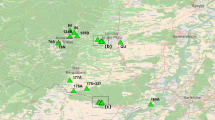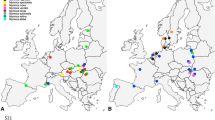Abstract
Four major hypotheses have been put forward to explain local species richness of commensal or parasitic species. The resource distribution hypothesis predicts that regionally widespread host species are able to support higher local species richness of commensals or parasites. On the other hand, the resource size hypothesis predicts that larger hosts can support more species than smaller hosts, and comparably, the resource abundance hypothesis predicts that hosts that offer more resources are able to support more species. Finally, the resource concentration hypothesis predicts that hosts that occur in high-density patches support higher species richness. In this study, we tested the first three of the above hypotheses with myrmecophilous beetles and their host ants. In addition to species richness of myrmecophilous beetles, we also applied the above hypotheses to explain the distribution of the beetles. Our data are exclusively based on an extensive literature survey. Myrmecophilous beetles live in naturally fragmented environments composed of host ant colonies and they are exclusively dependent on ants. We found that the distribution of the host ants and the colony size of the host ants had a positive effect on both the species richness and the distribution of myrmecophilous beetles. In the same way, we found that myrmecophilous beetle species that are generalists, i.e. have more than one host ant species, and thus have more abundant resources, were more widely distributed than specialist species. Thus, we found support for the hypothesis that resource distribution, resource size and resource abundance have an effect on species richness and on the distribution of species.






Similar content being viewed by others
References
Baroni Urbani C, Collingwood CA (1977) The zoogeography of ants (Hymenoptera, Formicidae) in Northern Europe. Acta Zool Fenn 152:1–34
Bock CE, Richlefs RE (1983) Range size and local abundance of some North American songbirds: a positive correlation. Am Nat 122:295–299
Brändle M, Brandl R (2001) Species richness of insects and mites on trees: expanding Southwood. J Anim Ecol 70:491–504
Breen J (1979) Worker populations of Formica lugubris Zett. nests in Irish plantation woods. Ecol Entomol 4:1–7
Brian MV (1950) The stable winter population structure in species of Myrmica. J Anim Ecol 19:119–123
Brown JH (1984) On the relationship between abundance and distribution of species. Am Nat 124:255–279
Christman MC, Culver DC (2001) The relationship between cave biodiversity and available habitat. J Biogeogr 28:367–380
Claridge MF, Wilson MR (1981) Host plant associations, diversity and species-area relationships of mesophyll-feeding leafhoppers of trees and shrubs in Britain. Ecol Entomol 6:217–238
Claridge MF, Wilson MR (1982) Insect herbivore guilds and species-area relationship: leaf-miners on British trees. Ecol Entomol 7:19–30
Collingwood CA (1979) The Formicidae (Hymenoptera) of Fennoscandia and Denmark. Entomol Scand 8:1–175
Cornell HV (1985) Local and regional richness of cynipine gall wasps on California oak. Ecology 66:1247–1260
Cornell HV, Lawton JH (1992) Species interactions, local and regional processes, and limits to the richness of ecological communities: a theoretical perspective. J Anim Ecol 61:1–12
Czechowski W (1990) Aggression of Formica aquilonia Yarr. to Camponotus ligniperdus (Latr.) (Hymenoptera, Formicidae) under the conditions of artificial colonization. Memorabilia Zool 44:83–91
Goncalves-Alvim SJ, Fernandes GW (2001) Biodiversity of galling insects: historical, community and habitat effects if four neotropical savannas. Biodivers Conserv 10:79–98
Hansen M (1996) Katalog over Danmarks biller. Entomol Medd 64: 1–231
Hölldobler B, Wilson EO (1990) The ants. Springer, Berlin Heidelberg New York
Hughes JB (2000) The scale of resource specialization and the distribution and abundance of Lycaenid butterflies. Oecologia 123:375–383
Hunter MD (1992) Interactions within herbivore communities mediated by the host plant: the keystone herbivory concept. In: Hunter MD, Ohgushi T, Price PW (eds) Effects of resource distribution on animal-plant interactions. Academic Press, New York, pp 287–325
Hunter MD, Wilmer PG (1989) The potential for interspecific competition between two abundant defoliators on oak: leaf damage and habitat quality. Ecol Entomol 14:267–277
Koch K (1989a) Die Käfer Mitteleuropas. Ökologie 1. Goecke and Evers, Krefeld
Koch K (1989b) Die Käfer Mitteleuropas. Ökologie 2. Goecke and Evers, Krefel
Koch K (1992) Die Käfer Mitteleuropas. Ökologie 3. Goecke and Evers, Krefel
Koizumi T, Fujiyama N, Katakura H (1999) Host-plant specificity limits the geographic distribution of thistle feeding ladybird beetles. Entomol Exp Appl 93:165–171
Komonen A, Penttilä R, Lindgren M, Hanski I (2000) Forest fragmentation truncates a food chain based on an old-growth forest bracket fungus. Oikos 90:119–1260
Lawton JH (1983) Plant architecture and the diversity of phytophagous insects. Annu Rev Entomol 28:23–39
Lewis CT, Waloff N (1964) The use of radioactive tracers in the study of dispersion of Orthotylus virescens (Douglas & Scott) (Miridae: Heteroptera). Entomol Exp Appl 7:15–24
Lundberg S, Gustafsson B (1995) Catalogus Coleopterorum Sueciae. Naturhistoriska Riksmuseet, Entomologiska Föreningen, Stockholm
MacArthur RH, Wilson EO (1967) The theory of island biogeography. Princeton University Press, Princeton, N.J.
Magagula CN, Samways MJ (2001) Maintenance of ladybeetle diversity across a heterogeneous African agricultural/savannah land mosaic. Biodivers Conserv 10:209–222
Marques ESA, Price PW, Cobb NS (2000) Resource abundance and insect herbivore diversity on woody Fabaceous desert plants. Environ Entomol 29:696–703
Morand S, Guegan J-F (2000) Distribution and abundance of parasite nematodes: ecological specialisation, phylogenetic constraint or simply epidemiology? Oikos 88:563–573
Neuvonen S, Niemelä P (1981) Species richness of Macrolepidoptera on Finnish deciduous trees and shrubs. Oecologia 51:364–370
Neuvonen S, Niemelä P (1983) Species richness and faunal similarity of arboreal insect herbivores. Oikos 40:452–459
Päivinen J, Ahlroth P, Kaitala V (2002) Ant-associated beetles of Fennoscandia and Denmark. Entomol Fenn 13:20–40
Quinn RM, Gaston KJ, Roy BR (1997) Coincidence between consumer and host occurrence: macrolepidoptera in Britain. Ecol Entomol 22:197–208
Quinn RM, Gaston KJ, Roy BR (1998) Coincidence in the distributions of butterflies and their food plants. Ecography 21:279–288
Rassi P (ed.) (1993) Frequency score of Coleoptera in Finland 1.1.1960–1.1.1990. Viestipaino, Helsinki
Ricklefs RE (1987) Community diversity: relative roles of local and regional processes. Science 167–171
Ricklefs RE, Miller GL (2000) Ecology. W.H. Freeman, New York
Root RB (1973) Organization of a plant-arthropod association in simple and diverse habitats: the fauna of collards (Brassica oleracea). Ecol Monogr 43:95–124
Roslin T, Koivunen A (2001) Distribution and abundance of dung beetles in fragmented landscapes. Oecologia 127:69–77
Sanches BC, Parmenter RR (2002) Patterns of shrub-dwelling arthropod diversity across a desert shrubland-grassland ecotone: a test of island biogeographic theory. J Arid Environ 50:247–265
Savolainen R, Vepsäläinen K (1988) A competition hierarchy among boreal ants: impact on resource partitioning and community structure. Oikos 51:135–155
Silfverberg H (1992) Enumeration Coleopterorum Fennoscandiae, Danie et Baltiae. Helsingin Hyönteisvaihtoyhdistys, Helsinki
Sundström L (1997) Queen acceptance and nestmate recognition in monogyne and polygyne colonies of the ant Formica truncorum. Anim Behav 53:499–510
Sverdrup-Thygeson A, Midtgaard F (1998) Fungus-infected trees as islands in boreal forest: spatial distribution of the fungivorous beetle Bolitophagus reticulatus (Coleoptera, Tenebrionodae). Ecoscience 5:486–493
Szymczakowski von W (1975) Unerwarteter Fund einer neuen Eocatops-Art in Schweden und Finnland (Col. Catopidae). Entomol Tidskr 96:3–7
Thomas JA, Rose RJ, Clarke RT, Thomas CD, Webb NR (1999) Intraspecific variation in habitat availability among ectotherm animals near their climatic limits and their centres of range. Funct Ecol 13:55–64
Webb MR, Pullin AS (2000) Egg distribution in the large copper butterfly Lycaena dispar batavus (Lepidoptera: Lycaenidae): host plant versus mediated effects. Eur J Entomol 97:363–367
Acknowledgements
We are grateful to Jouni Laakso, Satu Paukku, Tero Toivanen and Katja Tynkkynen for improving the manuscript. Special thanks to Atte Komonen and Tomas Roslin for their valuable comments. We also thank Pekka Punttila, Michael Saaristo, Jouni Sorvari and Lotta Sundström for their comments concerning the ecology of ants. The study was financially supported by the Academy of Finland (to V.K. and to J.S.K.), the Entomological Society of Finland (to J.P.), Finnish Centre of Excellence Programme 2000–2005 (V.K. and J.S.; project 44878), the Finnish Cultural Foundation / Central Finland (to J.P.), the Societas pro Fauna et Flora Fennica (to J.P.) and Jenny and Antti Wihuri Foundation (to J.P.).
Author information
Authors and Affiliations
Corresponding author
Rights and permissions
About this article
Cite this article
Päivinen, J., Ahlroth, P., Kaitala, V. et al. Species richness and regional distribution of myrmecophilous beetles. Oecologia 134, 587–595 (2003). https://doi.org/10.1007/s00442-002-1141-z
Received:
Accepted:
Published:
Issue Date:
DOI: https://doi.org/10.1007/s00442-002-1141-z




